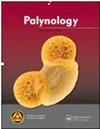Melissopalynological Investigations of Seasonal Honey Samples from the Greater Kruger National Park, Savanna Biome of South Africa
IF 1.3
4区 地球科学
Q3 PALEONTOLOGY
引用次数: 0
Abstract
ABSTRACT In melissopalynological studies, the investigation of pollen composition in honey samples reveals the geographical and botanical origin of the samples and links them to the regional climatic conditions. Honeybees (Apis mellifera), collect pollen and nectar for their nutritional requirements based on the seasonal availability of surrounding flora. In this study, pollen content in honey was temporarily investigated for seasonal differences of the bee foraged plants. A melissopalynological investigation was applied to honey samples harvested from 13 beehives located in the Greater Kruger National Park, South Africa. Multivariate statistics (NMDS and Rarefaction curves) were used to show spatial and temporal clustering of the samples. The melissopalynological data were then compared to the species' flowering season and a botanical survey of the surrounding area. The turnover in pollen composition for different seasons signifies seasonal variation in pollen types. For example, during summer, bees foraged from fewer floral sources. The highest species richness was observed during winter, suggesting a higher dependence on a diversity of floral resources during the driest months. Various seasonal pollen spectra were characterised by a pollen turnover from numerous species, including Combretum type, Sclerocarya birrea, Poaceae, Harpephyllum caffrum and Lannea schweinfurthii but also neophytes such as Medicago sativa. Therefore, honey samples from the Lowveld region in South Africa reflected the seasonal patterns of the surrounding flora although pollen from taxa such as Combretum spp. (average 56%) and Sclerocarya birrea (average 14%) were continuously sought after by bees throughout the year.南非大克鲁格国家公园热带稀树草原生物群系季节性蜂蜜样本的melissopynology调查
在蜂蜜花粉学研究中,对蜂蜜样品花粉组成的调查揭示了样品的地理和植物来源,并将它们与区域气候条件联系起来。蜜蜂(Apis mellifera)收集花粉和花蜜以满足其营养需求,这是基于周围植物的季节性可用性。本研究对蜂蜜中的花粉含量进行了临时调查,以了解蜜蜂觅食植物的季节差异。对南非大克鲁格国家公园的13个蜂箱采集的蜂蜜样本进行了蜂蜜学调查。采用多元统计(NMDS和稀疏曲线)来显示样本的时空聚类。然后将这些植物的植物学数据与该物种的开花季节和周围地区的植物调查进行比较。花粉组成在不同季节的更替反映了花粉类型的季节变化。例如,在夏季,蜜蜂从较少的花源中觅食。物种丰富度在冬季最高,表明在最干旱的月份对植物资源多样性的依赖程度较高。不同季节花粉谱的特征包括Combretum、Sclerocarya birrea、Poaceae、Harpephyllum caffrum和Lannea schweinfurthii以及Medicago sativa等新生植物的花粉周转。因此,尽管Combretum spp.(平均56%)和Sclerocarya birrea(平均14%)等分类群的花粉全年都被蜜蜂不断追求,但来自南非Lowveld地区的蜂蜜样本反映了周围植物区系的季节性模式。
本文章由计算机程序翻译,如有差异,请以英文原文为准。
求助全文
约1分钟内获得全文
求助全文
来源期刊

Palynology
地学-古生物学
CiteScore
3.40
自引率
26.70%
发文量
48
审稿时长
>12 weeks
期刊介绍:
Palynology is an international journal, and covers all aspects of the science. We accept papers on both pre-Quaternary and Quaternary palynology and palaeobotany. Contributions on novel uses of palynology, review articles, book reviews, taxonomic studies and papers on methodology are all actively encouraged.
 求助内容:
求助内容: 应助结果提醒方式:
应助结果提醒方式:


